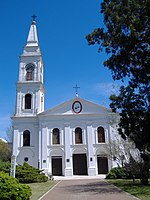Puerto General San Martín
Puerto General San Martín is a small city in the province of Santa Fe, Argentina, located within the metropolitan area of Greater Rosario, about 35 km (22 mi) north from the center of the city of Rosario, on the western shore of the Paraná River. It has a population of 13,243 inhabitants according to the 2010 census [INDEC]. The city is located on a natural port of excellent quality, with an abrupt ravine and great depth (dredged up to 34 feet (10 m) in 2006, it is the last deepwater, Panamax-capable port on the Paraná). The city is home to an industrial complex and a major commercial terminal for agricultural exports (cereals, vegetable oils, etc.), managing 50% of the Argentine exports of soybean. The industrial and agricultural development, secondary to the swift recovery from the Argentine economic crisis of the late 1990s, is however an important source of pollution.
Excerpt from the Wikipedia article Puerto General San Martín (License: CC BY-SA 3.0, Authors).Puerto General San Martín
9 de Julio, Municipio de Puerto General San Martín
Geographical coordinates (GPS) Address Nearby Places Show on map
Geographical coordinates (GPS)
| Latitude | Longitude |
|---|---|
| N -32.716666666667 ° | E -60.733333333333 ° |
Address
9 de Julio 250
S2202 Municipio de Puerto General San Martín, Centro
Santa Fe, Argentina
Open on Google Maps








